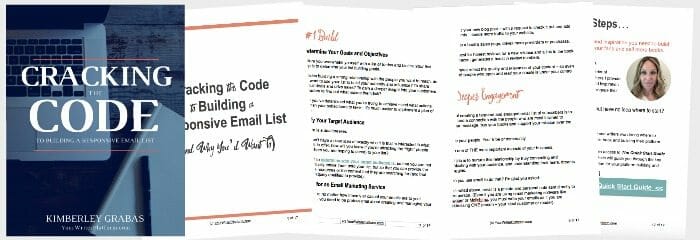Marketing is not a simple task.
It extends far beyond basic tips, tactics and hurriedly outlined strategies on the back of a napkin – if you expect results.
In today’s world of rapidly evolving digital media, an author’s book marketing strategy requires clear career objectives and goals, an understanding of what’s working right now (and what’s on track to pay dividends in the future), and some smart planning to tie it all together.
So, to help guide the development of your book marketing strategy, here’s a list of seven relevant (and significant) marketing trends that should not be overlooked.
#1. Relationship Marketing
With relationship marketing, the emphasis is on reader loyalty and longer-term engagement and interaction, rather than simply the one-time sale.
Your goal is to personalize the experience for each reader by factoring in your readers’ preferences, and by providing enriched, meaningful and useful content that solves their problem or satisfies a desire.
Personality, trust, openness, transparency, relevance and participation all come into play in relationship marketing. Exclusive content and connecting with people in the language they understand best, helps make your reader feel connected and unique.
Storytelling also plays an important role. Good stories are remembered and connect with an audience on an emotional level. Those that are tailored to (or involve your readers), while still sharing your story and narrative, are the most impactful.
Actionable Marketing Tip:
Place a greater emphasis on your reader’s “experience” in all points of contact with you and your work. Look for ways to develop strong connections with your readers by providing them with content that is tailored to their needs, wants and interests (through your writing, your website, social media, email, loyalty programs and surveys).
#2. Email Marketing
At first glance, building an email list may seem like just another to-do on a long list of promotional hoops you need to jump through to get a little traction…
But, it happens to be hands down, the single most important thing you can do to ensure the success and longevity of your publishing business or writing career.
Email is still one of the best ways to build relationships with your readers and turn a casual browser into an avid fan. And, it’s an extremely efficient and cost effective tool for sharing relevant informational and promotional content with your community of subscribers on an ongoing and timely basis.
By owning your own list (as opposed to gathering communities of fans on social media and other platforms besides your own), you can determine how you interact with your readers or customers, how often you choose to communicate with them, and even the type of content you share.
If you use email to nurture your relationships with your readers – by truly connecting and communicating with your audience and understanding their fears, dreams and struggles – you gain deeper engagement with the people who are most inclined to spread your message, buy your books and support your work over the long term.
Without a list, you’re talking to an empty room.
With a list of engaged and supportive fans, that room is now an auditorium – filled with people eager to listen.
Actionable Marketing Tip:
First, focus on building your list (determine your goals and objectives, clarify your target audience, sign up for an email marketing service, and develop your opt-in incentive). Next, nurture your list by discovering what your readers want, and giving it to them. And finally, multiply your list by developing advocate and influencer lists, optimizing your website to capture “leads”, and increase targeted traffic to your site).
Featured Download:
For a more in-depth look at email marketing and list building, I’ve created this free guide to help you with the “why” and the “how” of building a list of engaged and supportive readers: “Cracking the Code to Building a Responsive Email List (And Why You’d Want To)”.

#3. Marketing Automation
It may seem counter-intuitive to focus on personalization AND on setting up systems and processes that run on autopilot. However, if done right, increasing automation can lead to an even better experience for your audience, while freeing up your time to connect more meaningfully where it really counts.
Some examples of marketing automation:
- Setting up landing pages that present your opt-in incentive (a free chapter, novella, guide or cheatsheet) in a compelling way, captures your reader’s email address and then automatically delivers the incentive.
- Prewriting and scheduling social media updates using platforms like Buffer or Hootsuite.
- Create email autoresponder sequences to pull fans further into the fold (and lead them to buy current and future books, products or services). You can use these automatic email sequences to create sales “funnels” for your books or even customer follow up sequences, for after they buy.
The key to setting up successful systems that feel personalized (not robotic), is to spend some time tracking your “buyer’s journey”. What does a person experience as they move from their first point of contact with you (a blog post on your site, a Facebook ad, your book, Amazon, or perhaps an influencer recommendation) to purchasing your book, and beyond?
What can you add (or remove) that will improve the experience for your reader, as well as accomplish your goals?
Actionable Marketing Tip:
Determine how you would like people to move through their experience with you. Shape their impression by creating a pathway that is in line with your objectives (increase book sales, build authority, create a movement, etc.), AND satisfies their needs and interests.
#4. Content Marketing
The concept of content marketing can be a slippery one for authors, and yet – given your skill set– it’s the one trend that should be the easiest to follow.
Traditional marketing, and especially paid advertising, employs an interruption marketing method that “rents” people’s attention. Once you stop paying to capture your reader’s awareness, you can expect the majority of your results to stop as well.
Content marketing, on the other hand, allows you to build an audience (and results) for the long term. Working hand-in-hand with the relationship marketing trend, content marketing is an ongoing process that focuses on building loyalty and earning attention – not renting it.
“Content marketing is a strategic marketing approach focused on creating and distributing valuable, relevant, and consistent content to attract and retain a clearly-defined audience — and, ultimately, to drive profitable customer action.”
– Content Marketing Institute
Rather than selling or pitching your creative projects, you can develop relevant and valuable blog posts, videos, podcasts, social media conversations, ebooks, visual content and even share reader-generated content.
Focus on crafting visual, purposeful and interactive content:
- Blogs – one of the best forms of content marketing.
- Episodic Content – snippets of content that progress or have a storyline.
- Livestreaming – examples include Periscope and Facebook Live.
- Webinars – excellent for engagement and building your email list.
- Video – social video is exploding. Facebook more than doubled its daily video views to 8 billion, and video views on Twitter and Snapchat are climbing. Other alternatives include eight-second Vines, 15 Second Instagram videos or streaming video like Periscope.
- Crowd sourced fan content – make it easy and rewarding to share stories or create content about your books, settings and characters (or topic/genre).
Whether you are a nonfiction author whose goal it is to inform and educate your readers, or a fiction author hoping to ignite fan passion for your upcoming book series, an immersive content experience that allows a story to unfold for your audience, will rouse reader enthusiasm.
Actionable Marketing Tip:
Develop your content marketing strategy. Determine your goals and objectives and decide how you’ll measure your results. Identify and understand your audience and their specific needs, then create a content execution plan to guide your choices now, and in the future (what content will you deliver daily, weekly, monthly, and quarterly, in what medium and on what platform?).
#5. Visual Marketing
Show don’t tell.
Not only does this technique work in literature, but as limited attention spans seek information and meaning in faster and more concise forms, visual marketing has become an ever important tool in an author’s toolbox.
Studies have shown that the brain processes visual content 60,000 times faster than text.
With visual content more than 40X more likely to be shared on social media (Source and the amount of average daily video views doubling from 4 to 8 billion views per day (Source), it’s clear that the visual content trend shows no signs of slowing.
And while text-based content is still important in marketing, to really capture your reader’s attention, various types of visual content should also have an integral role. Some examples include:

- photos/images
- graphics
- videos
- infographics
- presentations
- memes
- image quotes
- screenshots
- buttons and other visual “call to actions”
(Original photo via Pexels)
Keep in mind that all your visual content should be branded and in line with the rest of your marketing, promotional and business story.
Actionable Marketing Tip:
Use visual storytelling to leverage the “show, don’t tell” principle to attract attention, enhance your author brand, and draw readers in. Be sure to include various types of visuals in your content execution plan, as well.
#6. Influencer Marketing
This trend is growing rapidly due to the impact social media has on the amplification of word-of-mouth marketing (and the importance of peer recommendations on readers’ book buying decisions).
To capitalize on this trend, you need to identify and engage with individuals that have influence over the audience you are trying to reach (and are a good match for your marketing objectives). This can take a few forms:
- industry spokespeople, better-known authors, celebrities (“internet famous”)
- those that have amassed huge followings on a niche topic
- experts in their field
Their endorsement of you and your work can lend you credibility in the eyes of the people you are trying to reach.
However, there is also another way to fuel the book marketing fire: galvanize your fans and advocates.
By providing an irresistible experience for your readers, you encourage authentic sharing of your book and naturally (inevitably) build a veritable army of supporters and word-of-mouth marketers for your work.
Actionable Marketing Tip:
Do your homework and make a list of industry influencers. Who does your target reader listen to, read or watch? Start developing connections with those that align with your message and mission. Then, develop a way to reward your most loyal and avid fans – think street team, membership/club or loyalty program.
#7. Mobile-focused Marketing
Whether you like where this trend is going or not, mobile is taking over.
Mobile media time is now greater than desktop and other media, which means that if you are not able to reach your readers via mobile (or you’re providing a less than satisfactory experience), you’re missing out.

(Original photo via Pexels)
Mobile optimization is also extremely important to Google, as more and more people are using their mobile devices to search and buy products (in 2015, the “Mobilegeddon” algorithm update was released to phase out websites not optimized for mobile).
Your job, then, is to use mobile to create better, more personalized and timely experiences for your reader:
- Ensure that while on your author website, book site or book sales/landing page, readers can easily read, engage, share or buy on their mobile devices.
- Email newsletters are easily viewed on a small screen.
- Pop-ups are disabled for mobile devices.
- Call to actions and purchase buttons are seamlessly integrated and work well on a mobile device.
- Video and other visuals are optimized and sized for small screens.
Actionable Marketing Tip:
Ensure your author site is mobile-responsive, with scannable and easy to read content. Size your email font large enough to be easily read on a phone, and ensure your visuals “pop” at a small size. Test your site, email newsletter and purchase process on many devices to see what the experience is like for your readers.
Take an Integrated Approach to Marketing Your Book
Marketing is not one dimensional. An integrated, multi-faceted approach is essential.
By adopting some (or all) of these current marketing trends, you can:
- Extend your reach and capture the attention of readers globally.
- Use technology and other (now affordable) resources to amplify your marketing efforts and scale your writing business.
- More easily measure results and your return on investment ROI, with data (not hunches) guiding your marketing decisions.
- Deepen your relationship with your readers and increase community engagement and sharing.
Marketing, platform building and developing your digital marketing assets should be looked upon as an investment in your future writing career. The connections you build, and the content you create today, will provide value to you (as an author) and to your readers, now and for years to come.
Photo: bigstockphoto.com


